VL70m synthesizer was designed as the companion MIDI tone generator for all the Yamaha WX series
wind controllers, although other controllers like those from Akai work very
well with the VL70m too. This synth was specifically designed to work with breath
control and has an on-board set of patches (voices) that can be immediately
played via breath control. Unlike more typical keyboard based synthesizers
which are velocity based, the VL70m synth was designed for breath based control
of voices. The VL70m is by far the most popular synthesizer module for wind synth players.
There's a direct plug-in port to connect any of the Yamaha WX series wind controllers.
The VL70m can only play one note at a time. This usually isn't a problem
for wind players, but if you want layering, drones, or double stops, you need to
add a second synthesizer. The VL1-m synth described below has two synth engines
internally, and can play two notes/voices at one time, allowing layering and
other effects.
Note: In mid-2013, Yamaha discontinued the VL70m. We are currently talking with Yamaha
to understand what they are recommending as a companion synth to go with the WX5 controller.
VL1-m Physically Modeled Synthesizer
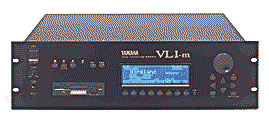
The Yamaha VL1-m synthesizer module is one of the most expressive synth modules
ever bult for wind control. While physically large in its 3U rack mount chassis,
the user interface and on-screen editing is incredibly flexible. The VL1m synth
generates its sounds through 'physical modeling' (PM) which is essentially
a set of math equations that describe how
vibrations would occur within an object. There are math equations for the object
which creates the vibrations, such as mouthpieces, reeds, violin bows, and buzzing lips.
There are also math equations for instrument bodies (tubes: like in a clarinet;
boxes: like in a cello), as well as other aspects of musical instruments - real or
imagined. The VL1-m synth takes these equations and computes the behavior of the
vibrations using very fast math computers, commonly called DSP chips (digital signal
processing chips). The result of all this intense computation is an audio waveform
which can then be amplified and brought to the real world through speakers. The result
is a synthesizer which sounds beautiful, and more importantly behaves like real
tubes with vibrations (i.e. clarinets, saxes, cellos).
For a wind synth player, where there are many variables which can be adjusted
while playing (i.e. wind velocity, bite pressure, etc.), the physically
modeled synthesizer can be made to behave like a physical
system would. The VL1-m has been discontinued by Yamaha, but the less expensive, single
voice physically modeled synthesizer, the VL70m has replaced it and is described above.
WT11 Wind Synthesizer (4-operator FM)
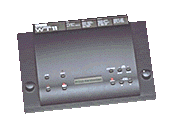
The WT11 is the companion MIDI tone generator to the WX11 controller. An older
technology "4-operator" FM synthesizer, the WT11 is no longer manufactured by Yamaha.
It is nearly indentical to the TX81Z and DX100 synths from Yamaha.
With patches (sounds) specifically designed
for wind control and an onboard digital reverb/effects capability, the WT11 allows
for quick access to the enhanced expressiveness of a wind controller. While the
4-operator FM technology isn't the latest thing on the block, it does indeed work
well with wind control. There's a direct plug-in port to connect any of the
Yamaha WX series wind controllers. Don't expect "sample quality" sounds of saxes, horns,
and guitars, but do expect a nice fat sound with lots of range to explore timbre
changes as you change blow pressure or reed pressure.
EWI-USB Wind Controller
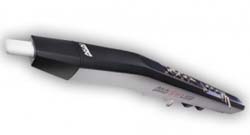 Akai's most affordable, turnkey wind controller is the the EWI-USB. Because it's USB, you plug this
directly into your computer and play the included software synth (softsynth).
This is an outstanding, instrument for any wind controller player just getting into
wind control. It's pricing is exceptionally low compared to other controllers
currently available. This is our current recommendation for people new to wind controllers.
Akai's most affordable, turnkey wind controller is the the EWI-USB. Because it's USB, you plug this
directly into your computer and play the included software synth (softsynth).
This is an outstanding, instrument for any wind controller player just getting into
wind control. It's pricing is exceptionally low compared to other controllers
currently available. This is our current recommendation for people new to wind controllers.
EWI5000 Wind Controller
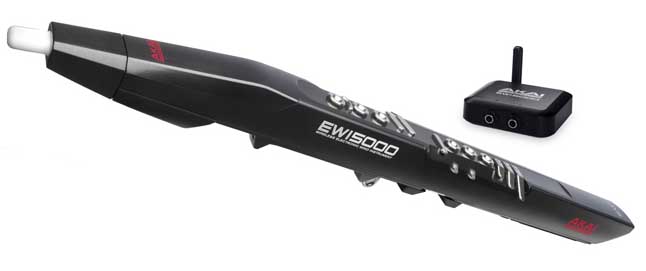 At the 2014 Winter NAMM (National Association of Music Merchants), Akai announced the EWI 5000 Wind Controller. This is a wireless controller in the familiar Akai EWI format including glide strip and octave rollers. Major retailers are reporting a selling price of $799. From the Akai press release:
At the 2014 Winter NAMM (National Association of Music Merchants), Akai announced the EWI 5000 Wind Controller. This is a wireless controller in the familiar Akai EWI format including glide strip and octave rollers. Major retailers are reporting a selling price of $799. From the Akai press release:
Akai Professional unleashed the EWI 5000, a new wind controller that delivers “authentic wind-instrument performance and response for the digital era.” The EWI 5000 automatically calibrates and adapts to your playing style, and it ships with 3GB of acoustic and progressive sounds by SONiVOX. It also sports USB and MIDI, plus wireless operation for freedom of movement onstage.
Akai Professional EWI 5000 Features:
- Wireless electronic wind instrument
- Genuine wind-instrument feel and performance for the digital era
- 3GB of acoustic and progressive sounds by SONiVOX
- Automatically calibrates and adapts to your playing style
- Wireless audio for on-stage freedom (includes receiver)
- USB port; MIDI out; 1/4″ audio out, 1/8″ headphone out
- Includes neck strap, charger, USB Cable, and wireless receiver
EWI4000S Wind Controller
 Akai's premier wind controller is the the EWI4000S, (soon to be replaced by the newly announced EWI5000).
This 4000S controller allows
outstanding breath response with additional controllers for
pitch bend (up and down), vibrato, and glide. The keys are
touch sensitive, and hence are lightning fast. This touch sensitivity,
coupled with the wide array of controllers makes this wind controller
from Akai very popular with players. Unlike
older Akai EWI models, the new EWI4000s has an on-board internal synthesizer
so you don't need to buy a separate synthsizer module. This internal synth
is analog style, so don't expect perfect digital samples like on a modern
synthesizer, but it's an organic, nice feeling synth very well suited for
wind control. And you can always connect the EWI4000s directly into any
MIDI synthesizer of your choosing. This is an outstanding, professional
instrument for any serious wind controller player.
Akai's premier wind controller is the the EWI4000S, (soon to be replaced by the newly announced EWI5000).
This 4000S controller allows
outstanding breath response with additional controllers for
pitch bend (up and down), vibrato, and glide. The keys are
touch sensitive, and hence are lightning fast. This touch sensitivity,
coupled with the wide array of controllers makes this wind controller
from Akai very popular with players. Unlike
older Akai EWI models, the new EWI4000s has an on-board internal synthesizer
so you don't need to buy a separate synthsizer module. This internal synth
is analog style, so don't expect perfect digital samples like on a modern
synthesizer, but it's an organic, nice feeling synth very well suited for
wind control. And you can always connect the EWI4000s directly into any
MIDI synthesizer of your choosing. This is an outstanding, professional
instrument for any serious wind controller player.
EWI3020 Wind Controllers
 Akai has produced many fine wind
controllers prior to the EWI4000S, specifically the
EWI3020 electronic wind instrument. Now out of production, the EWI3020
wind controller allows outstanding breath response with additional
controllers for pitch bend (up and down), vibrato, and glide. As noted on the
EWI4000s, the keys are touch sensitive and very fast. This touch sensitivity
can be a challenge for sax players used to resting fingers on the keys, but
it's a short learning curve to get used to the touch keys.
This controller does not make any sounds itself, but just generates
6 analog voltages (key, octave, breath, vibe, glide) that are fed
to a "brainbox" synth module. There are two models made
by Akai as required companions to the EWI3020 wind controller. There is
no built-in synth, as that was part of the required rack modules (see below).
Akai has produced many fine wind
controllers prior to the EWI4000S, specifically the
EWI3020 electronic wind instrument. Now out of production, the EWI3020
wind controller allows outstanding breath response with additional
controllers for pitch bend (up and down), vibrato, and glide. As noted on the
EWI4000s, the keys are touch sensitive and very fast. This touch sensitivity
can be a challenge for sax players used to resting fingers on the keys, but
it's a short learning curve to get used to the touch keys.
This controller does not make any sounds itself, but just generates
6 analog voltages (key, octave, breath, vibe, glide) that are fed
to a "brainbox" synth module. There are two models made
by Akai as required companions to the EWI3020 wind controller. There is
no built-in synth, as that was part of the required rack modules (see below).
 The Akai EWI3020m is a 2U rack style "brainbox" and analog synth module
designed specifically to go with the EWI3020. Like the EWI3020, this
is out of production now, but available on the used instrument market.
The interface portion of the module sends power to the EWI
wind controller, as well as conditions and digitizes the 6 analog
voltages that control the synthesizer. In addition to control of
the included analog synth, the unit also has MIDI in, out, and thru
for connection to other synths. One big feature of this module is
the ability to play chords, as well as a unique "External Analog
Input" function that allows the Akai EWI3020 wind controller to control
externally generated analog signals.
The Akai EWI3020m is a 2U rack style "brainbox" and analog synth module
designed specifically to go with the EWI3020. Like the EWI3020, this
is out of production now, but available on the used instrument market.
The interface portion of the module sends power to the EWI
wind controller, as well as conditions and digitizes the 6 analog
voltages that control the synthesizer. In addition to control of
the included analog synth, the unit also has MIDI in, out, and thru
for connection to other synths. One big feature of this module is
the ability to play chords, as well as a unique "External Analog
Input" function that allows the Akai EWI3020 wind controller to control
externally generated analog signals.
 The Akai EWI3030m is a 2U rack style synth module like the above
noted EWI3020m, but based on digital
samples and control. Unlike the analog synth engine in the 3020m,
the 3030m is equipped with digital synthesizer electronics for
sound production. This module, also discontinued, performs all the same
"brainbox" functions as the EWI3020m, as well as External Analog
Input and chord playing. EWI3020 controllers can plug into either the
EWI3020m or EWI3030m. Only one is required.
The Akai EWI3030m is a 2U rack style synth module like the above
noted EWI3020m, but based on digital
samples and control. Unlike the analog synth engine in the 3020m,
the 3030m is equipped with digital synthesizer electronics for
sound production. This module, also discontinued, performs all the same
"brainbox" functions as the EWI3020m, as well as External Analog
Input and chord playing. EWI3020 controllers can plug into either the
EWI3020m or EWI3030m. Only one is required.
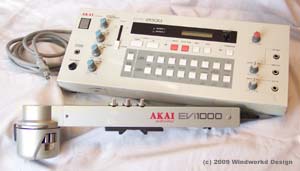 The Akai EVI1000 is a wind controller from the late 1980's that used
trumpet style fingerings. Despite it's trumpet fingerings, the mouthpiece
is a pressure sensor with bite sensor of a design common with all EWI
instruments. Because you don't "buzz" your lips or overblow,
to access the 4th you touch a sense button on the canister. Speaking
of the canister, it's a rotating plastic housing that allows your left
thumb to roll over the octave keys. This cannister looking octave housing
gives the instrument it's distinstive shape, and the original players
sometimes called this EVI the "bug sprayer". The EVI1000 controller required
the EWV2000 3U rack style synth module to interface with the controller,
produce sounds with it's onboard analog synthesizer, and produce midi output.
The Akai EVI1000 is a wind controller from the late 1980's that used
trumpet style fingerings. Despite it's trumpet fingerings, the mouthpiece
is a pressure sensor with bite sensor of a design common with all EWI
instruments. Because you don't "buzz" your lips or overblow,
to access the 4th you touch a sense button on the canister. Speaking
of the canister, it's a rotating plastic housing that allows your left
thumb to roll over the octave keys. This cannister looking octave housing
gives the instrument it's distinstive shape, and the original players
sometimes called this EVI the "bug sprayer". The EVI1000 controller required
the EWV2000 3U rack style synth module to interface with the controller,
produce sounds with it's onboard analog synthesizer, and produce midi output.
Morrison Digital Trumpet Wind Controller
 The Morrison Digital Trumpet (MDT) is a wind controller based on a trumpet fingering. Modern in every respect,
this wind controller is a more familiar holding and blowing configuration than
the EVI or other early trumpet controllers. With a solid state pressure sensor,
10 octave range, this wind controller will produce midi output directly, providing
10 controllers (2 buttons, 3 sensors, and 5 assigned to the breath sensor).
The Morrison Digital Trumpet (MDT) is a wind controller based on a trumpet fingering. Modern in every respect,
this wind controller is a more familiar holding and blowing configuration than
the EVI or other early trumpet controllers. With a solid state pressure sensor,
10 octave range, this wind controller will produce midi output directly, providing
10 controllers (2 buttons, 3 sensors, and 5 assigned to the breath sensor).
XPression Synthesizer Module
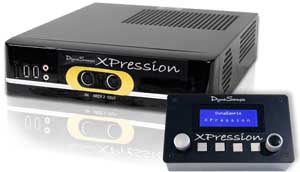 The XPression synthesizer module is considered a best in class synthesizer
module for wind controllers. It combines sampling with modeling to create excellent wind
voices. While we have not tried this module here at WindWorks Design, many of our trusted
wind synth players are very pleased with the XPression and recommend it. The downside it that
it's quite expensive.
The XPression synthesizer module is considered a best in class synthesizer
module for wind controllers. It combines sampling with modeling to create excellent wind
voices. While we have not tried this module here at WindWorks Design, many of our trusted
wind synth players are very pleased with the XPression and recommend it. The downside it that
it's quite expensive.

 The Yamaha WX series allows a wind player access
to a wide variety of synthesizer sounds through the expressiveness of a wind
instrument. These controllers do not make any sounds by themselves, but
generate a MIDI data stream to any external MIDI synthesizer (tone generator).
The Yamaha WX series allows a wind player access
to a wide variety of synthesizer sounds through the expressiveness of a wind
instrument. These controllers do not make any sounds by themselves, but
generate a MIDI data stream to any external MIDI synthesizer (tone generator).

 VL70m synthesizer was designed as the companion MIDI tone generator for all the Yamaha WX series
wind controllers, although other controllers like those from Akai work very
well with the VL70m too. This synth was specifically designed to work with breath
control and has an on-board set of patches (voices) that can be immediately
played via breath control. Unlike more typical keyboard based synthesizers
which are velocity based, the VL70m synth was designed for breath based control
of voices. The VL70m is by far the most popular synthesizer module for wind synth players.
There's a direct plug-in port to connect any of the Yamaha WX series wind controllers.
VL70m synthesizer was designed as the companion MIDI tone generator for all the Yamaha WX series
wind controllers, although other controllers like those from Akai work very
well with the VL70m too. This synth was specifically designed to work with breath
control and has an on-board set of patches (voices) that can be immediately
played via breath control. Unlike more typical keyboard based synthesizers
which are velocity based, the VL70m synth was designed for breath based control
of voices. The VL70m is by far the most popular synthesizer module for wind synth players.
There's a direct plug-in port to connect any of the Yamaha WX series wind controllers.
 The Yamaha VL1-m synthesizer module is one of the most expressive synth modules
ever bult for wind control. While physically large in its 3U rack mount chassis,
the user interface and on-screen editing is incredibly flexible. The VL1m synth
generates its sounds through 'physical modeling' (PM) which is essentially
a set of math equations that describe how
vibrations would occur within an object. There are math equations for the object
which creates the vibrations, such as mouthpieces, reeds, violin bows, and buzzing lips.
There are also math equations for instrument bodies (tubes: like in a clarinet;
boxes: like in a cello), as well as other aspects of musical instruments - real or
imagined. The VL1-m synth takes these equations and computes the behavior of the
vibrations using very fast math computers, commonly called DSP chips (digital signal
processing chips). The result of all this intense computation is an audio waveform
which can then be amplified and brought to the real world through speakers. The result
is a synthesizer which sounds beautiful, and more importantly behaves like real
tubes with vibrations (i.e. clarinets, saxes, cellos).
For a wind synth player, where there are many variables which can be adjusted
while playing (i.e. wind velocity, bite pressure, etc.), the physically
modeled synthesizer can be made to behave like a physical
system would. The VL1-m has been discontinued by Yamaha, but the less expensive, single
voice physically modeled synthesizer, the VL70m has replaced it and is described above.
The Yamaha VL1-m synthesizer module is one of the most expressive synth modules
ever bult for wind control. While physically large in its 3U rack mount chassis,
the user interface and on-screen editing is incredibly flexible. The VL1m synth
generates its sounds through 'physical modeling' (PM) which is essentially
a set of math equations that describe how
vibrations would occur within an object. There are math equations for the object
which creates the vibrations, such as mouthpieces, reeds, violin bows, and buzzing lips.
There are also math equations for instrument bodies (tubes: like in a clarinet;
boxes: like in a cello), as well as other aspects of musical instruments - real or
imagined. The VL1-m synth takes these equations and computes the behavior of the
vibrations using very fast math computers, commonly called DSP chips (digital signal
processing chips). The result of all this intense computation is an audio waveform
which can then be amplified and brought to the real world through speakers. The result
is a synthesizer which sounds beautiful, and more importantly behaves like real
tubes with vibrations (i.e. clarinets, saxes, cellos).
For a wind synth player, where there are many variables which can be adjusted
while playing (i.e. wind velocity, bite pressure, etc.), the physically
modeled synthesizer can be made to behave like a physical
system would. The VL1-m has been discontinued by Yamaha, but the less expensive, single
voice physically modeled synthesizer, the VL70m has replaced it and is described above.
 The WT11 is the companion MIDI tone generator to the WX11 controller. An older
technology "4-operator" FM synthesizer, the WT11 is no longer manufactured by Yamaha.
It is nearly indentical to the TX81Z and DX100 synths from Yamaha.
With patches (sounds) specifically designed
for wind control and an onboard digital reverb/effects capability, the WT11 allows
for quick access to the enhanced expressiveness of a wind controller. While the
4-operator FM technology isn't the latest thing on the block, it does indeed work
well with wind control. There's a direct plug-in port to connect any of the
Yamaha WX series wind controllers. Don't expect "sample quality" sounds of saxes, horns,
and guitars, but do expect a nice fat sound with lots of range to explore timbre
changes as you change blow pressure or reed pressure.
The WT11 is the companion MIDI tone generator to the WX11 controller. An older
technology "4-operator" FM synthesizer, the WT11 is no longer manufactured by Yamaha.
It is nearly indentical to the TX81Z and DX100 synths from Yamaha.
With patches (sounds) specifically designed
for wind control and an onboard digital reverb/effects capability, the WT11 allows
for quick access to the enhanced expressiveness of a wind controller. While the
4-operator FM technology isn't the latest thing on the block, it does indeed work
well with wind control. There's a direct plug-in port to connect any of the
Yamaha WX series wind controllers. Don't expect "sample quality" sounds of saxes, horns,
and guitars, but do expect a nice fat sound with lots of range to explore timbre
changes as you change blow pressure or reed pressure.
 Akai's most affordable, turnkey wind controller is the the EWI-USB. Because it's USB, you plug this
directly into your computer and play the included software synth (softsynth).
This is an outstanding, instrument for any wind controller player just getting into
wind control. It's pricing is exceptionally low compared to other controllers
currently available. This is our current recommendation for people new to wind controllers.
Akai's most affordable, turnkey wind controller is the the EWI-USB. Because it's USB, you plug this
directly into your computer and play the included software synth (softsynth).
This is an outstanding, instrument for any wind controller player just getting into
wind control. It's pricing is exceptionally low compared to other controllers
currently available. This is our current recommendation for people new to wind controllers.
 At the 2014 Winter NAMM (National Association of Music Merchants), Akai announced the EWI 5000 Wind Controller. This is a wireless controller in the familiar Akai EWI format including glide strip and octave rollers. Major retailers are reporting a selling price of $799. From the Akai press release:
At the 2014 Winter NAMM (National Association of Music Merchants), Akai announced the EWI 5000 Wind Controller. This is a wireless controller in the familiar Akai EWI format including glide strip and octave rollers. Major retailers are reporting a selling price of $799. From the Akai press release:  Akai has produced many fine wind
controllers prior to the EWI4000S, specifically the
EWI3020 electronic wind instrument. Now out of production, the EWI3020
wind controller allows outstanding breath response with additional
controllers for pitch bend (up and down), vibrato, and glide. As noted on the
EWI4000s, the keys are touch sensitive and very fast. This touch sensitivity
can be a challenge for sax players used to resting fingers on the keys, but
it's a short learning curve to get used to the touch keys.
This controller does not make any sounds itself, but just generates
6 analog voltages (key, octave, breath, vibe, glide) that are fed
to a "brainbox" synth module. There are two models made
by Akai as required companions to the EWI3020 wind controller. There is
no built-in synth, as that was part of the required rack modules (see below).
Akai has produced many fine wind
controllers prior to the EWI4000S, specifically the
EWI3020 electronic wind instrument. Now out of production, the EWI3020
wind controller allows outstanding breath response with additional
controllers for pitch bend (up and down), vibrato, and glide. As noted on the
EWI4000s, the keys are touch sensitive and very fast. This touch sensitivity
can be a challenge for sax players used to resting fingers on the keys, but
it's a short learning curve to get used to the touch keys.
This controller does not make any sounds itself, but just generates
6 analog voltages (key, octave, breath, vibe, glide) that are fed
to a "brainbox" synth module. There are two models made
by Akai as required companions to the EWI3020 wind controller. There is
no built-in synth, as that was part of the required rack modules (see below).
 The Akai EWI3020m is a 2U rack style "brainbox" and analog synth module
designed specifically to go with the EWI3020. Like the EWI3020, this
is out of production now, but available on the used instrument market.
The interface portion of the module sends power to the EWI
wind controller, as well as conditions and digitizes the 6 analog
voltages that control the synthesizer. In addition to control of
the included analog synth, the unit also has MIDI in, out, and thru
for connection to other synths. One big feature of this module is
the ability to play chords, as well as a unique "External Analog
Input" function that allows the Akai EWI3020 wind controller to control
externally generated analog signals.
The Akai EWI3020m is a 2U rack style "brainbox" and analog synth module
designed specifically to go with the EWI3020. Like the EWI3020, this
is out of production now, but available on the used instrument market.
The interface portion of the module sends power to the EWI
wind controller, as well as conditions and digitizes the 6 analog
voltages that control the synthesizer. In addition to control of
the included analog synth, the unit also has MIDI in, out, and thru
for connection to other synths. One big feature of this module is
the ability to play chords, as well as a unique "External Analog
Input" function that allows the Akai EWI3020 wind controller to control
externally generated analog signals.
 The Akai EWI3030m is a 2U rack style synth module like the above
noted EWI3020m, but based on digital
samples and control. Unlike the analog synth engine in the 3020m,
the 3030m is equipped with digital synthesizer electronics for
sound production. This module, also discontinued, performs all the same
"brainbox" functions as the EWI3020m, as well as External Analog
Input and chord playing. EWI3020 controllers can plug into either the
EWI3020m or EWI3030m. Only one is required.
The Akai EWI3030m is a 2U rack style synth module like the above
noted EWI3020m, but based on digital
samples and control. Unlike the analog synth engine in the 3020m,
the 3030m is equipped with digital synthesizer electronics for
sound production. This module, also discontinued, performs all the same
"brainbox" functions as the EWI3020m, as well as External Analog
Input and chord playing. EWI3020 controllers can plug into either the
EWI3020m or EWI3030m. Only one is required.
 The Akai EVI1000 is a wind controller from the late 1980's that used
trumpet style fingerings. Despite it's trumpet fingerings, the mouthpiece
is a pressure sensor with bite sensor of a design common with all EWI
instruments. Because you don't "buzz" your lips or overblow,
to access the 4th you touch a sense button on the canister. Speaking
of the canister, it's a rotating plastic housing that allows your left
thumb to roll over the octave keys. This cannister looking octave housing
gives the instrument it's distinstive shape, and the original players
sometimes called this EVI the "bug sprayer". The EVI1000 controller required
the EWV2000 3U rack style synth module to interface with the controller,
produce sounds with it's onboard analog synthesizer, and produce midi output.
The Akai EVI1000 is a wind controller from the late 1980's that used
trumpet style fingerings. Despite it's trumpet fingerings, the mouthpiece
is a pressure sensor with bite sensor of a design common with all EWI
instruments. Because you don't "buzz" your lips or overblow,
to access the 4th you touch a sense button on the canister. Speaking
of the canister, it's a rotating plastic housing that allows your left
thumb to roll over the octave keys. This cannister looking octave housing
gives the instrument it's distinstive shape, and the original players
sometimes called this EVI the "bug sprayer". The EVI1000 controller required
the EWV2000 3U rack style synth module to interface with the controller,
produce sounds with it's onboard analog synthesizer, and produce midi output.
 The Morrison Digital Trumpet (MDT) is a wind controller based on a trumpet fingering. Modern in every respect,
this wind controller is a more familiar holding and blowing configuration than
the EVI or other early trumpet controllers. With a solid state pressure sensor,
10 octave range, this wind controller will produce midi output directly, providing
10 controllers (2 buttons, 3 sensors, and 5 assigned to the breath sensor).
The Morrison Digital Trumpet (MDT) is a wind controller based on a trumpet fingering. Modern in every respect,
this wind controller is a more familiar holding and blowing configuration than
the EVI or other early trumpet controllers. With a solid state pressure sensor,
10 octave range, this wind controller will produce midi output directly, providing
10 controllers (2 buttons, 3 sensors, and 5 assigned to the breath sensor).
 The XPression synthesizer module is considered a best in class synthesizer
module for wind controllers. It combines sampling with modeling to create excellent wind
voices. While we have not tried this module here at WindWorks Design, many of our trusted
wind synth players are very pleased with the XPression and recommend it. The downside it that
it's quite expensive.
The XPression synthesizer module is considered a best in class synthesizer
module for wind controllers. It combines sampling with modeling to create excellent wind
voices. While we have not tried this module here at WindWorks Design, many of our trusted
wind synth players are very pleased with the XPression and recommend it. The downside it that
it's quite expensive.